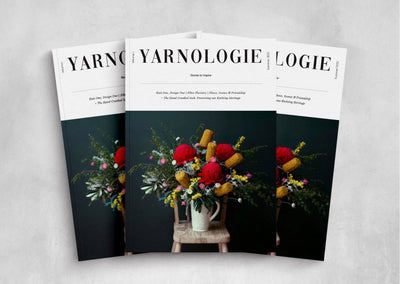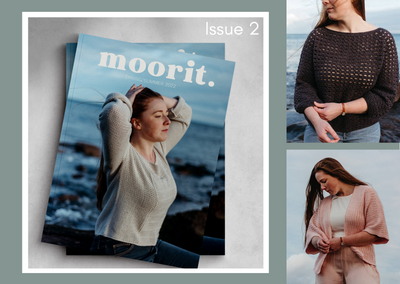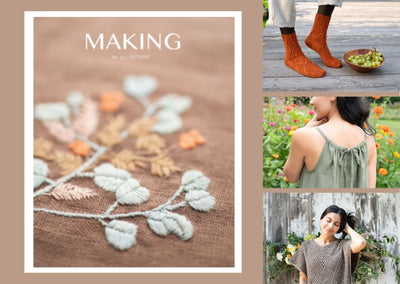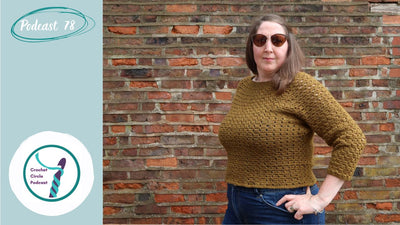
CRAFTING IS THE NEW COOL
About a 4 minute read
WHY SO MANY NEW CRAFTERS?
There is a crafting revolution going on. Some of you may have noticed it, others may believe that the likes of crocheting and knitting remains the domain of an older generation and that the skills are slowly being lost.
What I can guarantee is that crafting is very much alive, fibre-based crafts in particular are far from being the hobby of the granny, and are practiced throughout the generations.
What’s more is that the crafting wisdom of old isn’t just being passed through the generations, it is also being updated and improved upon.
So why has there been such a resurgence in crochet and knitting? I personally think it is for a number of reasons:
- Crafting is good for your mental health.
- It offers an escape from the social media doom scroll.
- Making your own items is a step away from fast fashion.
- Fast fashion shapes and sizes are based on standard measurements and a handmade wardrobe allows for tailored pieces.
- Celebrities have been wearing handmade crochet and knitwear garments and are also making their own.
GOOD FOR YOUR MENTAL HEALTH
According to the Craft Council:
“Craft can alleviate the symptoms of anxiety, depression, loneliness and even dementia…”
Personally, I try to craft every single day. There is a difference in me when I don’t and my busy life seems to be bear down on me with greater weight.
I am very attracted to goals and targets that provide me with lots of little dopamine hits. Crocheting and knitting gives me that every time I reach the end of a row, round, section, colour change. Every single change provides me with a dopamine hit and it makes me very happy.

It's not just about tasking myself to work through a project though, the act of crocheting and knitting is multi-sensory. I love working with proper British woolly wool. Each length of wool has different textures in it, bits of vegetation - it even smells sheepy. All of these sensations that I can feel, see, smell and sometimes even taste (when I spit-splice two ends together) are promoting joy and reducing my stress levels.
ESCAPE MINDLESS SCROLLING
If like me you love to multi-task whenever possible, then you will still be using technology as you craft. I often listen to a podcast, music or audio book while I am crafting, or catch up with video podcasters on YouTube. What I’m not doing is flicking through social media. Instead, I am learning, making something with my hands, lowering my stress levels and enjoying myself.
STEPPING AWAY FROM FAST FASHION
Fast fashion is based around the rapid design, production and marketing of high volume/ low quality clothing for the mass market. It’s cheap and often the manufacturing process has questionable ethical and environmental practices.
Then there is the issue of how quickly fast fashion items are deemed unfashionable and are disposed of. In the UK alone, 350,000 tonnes of clothing is landfilled per annum. That equates to a massive £140m of clothing/resources being thrown away.
A further 700,000 tonnes per annum is being sent to charities via shops, collections, textile banks and recycling centres. That’s over a million tonnes of UK clothes being wasted or recycled every year!


The solution is the antithesis of fast fashion - slow fashion. Generally slow fashion isn’t made for the mass market, and considers things like:
- Non-fashion led garments to break the fashion/trend cycle and will be worn for years to come.
- A sustainable and ethical supply chain.
- Garments that are either made locally or made further afield without human exploitation.
- Quality materials that are long lasting and can be darned and repaired with ease.
- Life-time free repairs like the one offered by Hiut Denim Company in Cardigan, Wales. They only make jeans, and if you get a rip in them, you can send them back and they will repair them for you, free of charge.


For the hand crafters out there, making your own garments and accessories is often the first step away from fast fashion.
By its very nature, crocheting or knitting a jumper has to be slow fashion, because it’s a slow, handmade process. It generally takes me about 30-50 hours to make jumper. It’s worth every single second because I get so much enjoyment from the act of making the thing and then I get to wear it at the end of the process too.
As a slight aside, unlike knitwear, true crochet cannot be made my machines. If you see a piece of crochet in a shop at a ridiculously low price, somebody else is paying the cost because it was made at disgustingly low cost. Please don't buy it, learn to make your own instead.
HANDMADE CAN BE SIZE & SHAPE INCLUSIVE
The fast fashion items available online and in the high street are designed using sets of standard measurements. This isn't an issue in itself because you have to be able to base your designs on a set of measurements to be able to make different sizes.
However, the use of standard sizes can lead to issues around size inclusivity (usually the sizes at either end of the spectrum are underserved) and shape inclusivity.
Most tops and jumpers are based on a B cup bust, so if you are flat chested or have a large bust, many fast fashion items just aren't going to fit right.
I am pleased to say that many handmade crochet and knitwear designers are taking the issues of size and shape inclusivity seriously. This offers crafters the opportunity to buy patterns from designers that are doing the work to offer customers garments that can be made for a 30" to 62" bust. But size inclusivity is only the first step to inclusivity.
The next step is to offer adaptations within the pattern to allow for bigger/smaller busts, waists that are smaller/bigger than busts, longer/shorter torsos, longer/shorter sleeves or bigger/smaller armhole circumference.
Patterns with these extra 'recipe' details allow crafters to make garments that are fitted for their bodies in a way that high street, mass-produced clothing never will.
So, when makers start questioning the ethics, sustainability and fit of fast fashion, handmade becomes a viable alternative.
CELEBRITY CRAFTERS
For as long as I been crafting, I have heard tales of celebrities that knit and crochet. Many are actors with lots of down time between sets where they are stuck in trailers. Think Madonna, Krysten Ritter (AKA Jessica Jones) and some, like Michelle Obama, picked up needles during lock-down.
However, there are two celebrities that really catapulted crochet and knitwear into the mainstream.
Do you remember when Harry Styles broke the internet with an over-sized multi-coloured cardigan? It was by JW Anderson and although they sold out very quickly (at £1250 a pop), the design concept went viral and crafters were soon crocheting and knitting their own versions of the design, making it up as they went.
Jonathan has since released the pattern free of charge so that fans can create a replica of the Harry Styles original.

Then came British Olympic Swimming medallist, Tom Daley. Tom started crocheting during lock-down and then knitting and now has his own company selling designs and kits ‘Made with Love by Tom Daley’.

I could be salty about the fact that men wearing or making their own clothes is somehow newsworthy (eye roll), but instead, I will love the fact that the column inches and TikTok videos devoted to their handmade items encouraged lots of younger people to venture into yarn shops to take up crocheting and knitting.
And just like that, crafting became the new cool.
IF YOU ARE NEW TO CRAFTING?
There are so many different crafts to try out. My main piece of advice would be to understand first how you like to learn. Is it through video, books, or face to face sessions?
I know that my favourite way to learn is through face to face learning. That’s how I learned to crochet back in 2014, through the adult education evening classes with my local authority. Previous attempts to learn through YouTube were abysmal.
All of this also comes with a word of caution. Once you pop, you can’t stop!
It started with crochet, then came knitting, macrame, embroidery, natural dyeing, spinning, machine sewing, tapestry, cross stitch, weaving, pottery, woodwork and tonight I’m on a live Zoom course with Flora Collingwood-Norris learning visible mending techniques to continue my slow fashion journey.
SOME OF MY FAVOURITE CRAFTING RESOURCES
Patterns
Find favourite designers through Pinterest and Instagram
British wools
Magazines
Making Magazine (knitting, crochet, sewing, embroidery rag rugging and so much more)
Garment and Accessory Designers
LET'S KEEP IN TOUCH
It would be lovely to hear from you on Instagram or Pinterest. I also have a monthly(ish) newsletter which you can sign up for below.
About Fay Dashper-Hughes

My name is Fay and I design crochet and knitwear patterns. I love proper woolly wool and showing crochet off for the beautiful, versatile craft that it actually is. Inspired by nature, architecture, Scottish landscapes and British wool.
Generally found in my happy place, my craft studio, affectionately known as The Hive.




















https://github.com/HoyDiamond/DiamondSeo01/issues/2
https://github.com/qianjiahao/MongoDB/issues/2
https://github.com/u21h2/nacs/issues/13
https://github.com/Programming-from-A-to-Z/A2Z-F15/issues/31
https://github.com/qw3rtman/p/issues/35
https://github.com/Pleumpi1688/Kittichaiya1680/discussions/1
https://github.com/rafaballerini/GitTutorial/issues/200
https://github.com/Yalantis/uCrop/issues/948
https://github.com/SaeruHikari/SakuraEngine-Old/issues/3
https://github.com/xyba1337/ValorantEZTS/issues/3
https://github.com/henryjeff/portfolio-website/issues/16
https://github.com/EllanJiang/GameFramework/issues/76
https://patcharapdiamond168.graphy.com/courses/DHSeo168Diamond
https://suvanabhumi168.graphy.com/courses/Ruayy44Diamond168
https://patcharapdiamond168.graphy.com/courses/DiamondRray789168
https://cccv.to/uezudxbstufpt
https://cccv.to/tuemv
https://cccv.to/zsf62
https://cccv.to/7n6eye1jzk2u5ta
https://cccv.to/5cqn8t79w2ernmd
https://cccv.to/nnhft
https://cccv.to/ieimy1r4g452w
http://diamondlnwpg168.com/
https://paiklangna.com/
http://diamondlnwpg168.com/
https://paiklangna.com/
https://suvanabhumi168.graphy.com/courses/RuayDiamond168V1
https://suvanabhumi168.graphy.com/courses/DiamondLottoo7168
https://cccv.to/c9equ1
https://cccv.to/sagame168
https://cccv.to/km5jte
https://cccv.to/83yx613wp8rb
https://cccv.to/2z7ncimc
https://cccv.to/24ntippanfgz4
https://cccv.to/advpidfpyw
https://cccv.to/p1xn1
https://patcharapdiamond168.graphy.com/courses/DHSeo168Diamond
https://suvanabhumi168.graphy.com/courses/Ruayy44Diamond168
https://patcharapdiamond168.graphy.com/courses/DiamondRray789168
https://cccv.to/uezudxbstufpt
https://cccv.to/tuemv
https://cccv.to/zsf62
https://cccv.to/7n6eye1jzk2u5ta
https://cccv.to/5cqn8t79w2ernmd
https://cccv.to/nnhft
https://cccv.to/ieimy1r4g452w
http://diamondlnwpg168.com/
https://paiklangna.com/
https://github.com/kaina134556666666666/kaina123/issues/1
https://github.com/Thanaratchaku/Thammapak-/issues/1
https://github.com/Reongsamai/Pipattanakul/issues/1
https://github.com/Jarassopon/Chartpipak-/issues/1
https://github.com/Prommabuth/Srisarawong/issues/1
https://github.com/Thammapak/Srisawatwongchai-/issues/1
https://github.com/Gongkiatsakul/Pichitcharoenwong-/issues/1
https://github.com/Narinchanok/Anansapcharoen/issues/1
https://github.com/Panichvattanaku/Pichitcharoenwong-/issues/1
https://github.com/Vichayaprasertkul/Siripapan/issues/1
https://github.com/Nitithamrong/Rattanaprasert/issues/1
https://github.com/Rattanaprasit22/Udomsawatdisuk-/issues/1
https://github.com/Chakraphanpradit/Kajornsakkoso/issues/1
https://github.com/Gongkiatsakul/Pichitcharoenwong-/issues/1
https://github.com/Narinchanok/Anansapcharoen/issues/1
https://github.com/Panichvattanaku/Pichitcharoenwong-/issues/1
https://github.com/Vichayaprasertkul/Siripapan/issues/1
https://github.com/Nitithamrong/Rattanaprasert/issues/1
https://github.com/Rattanaprasit22/Udomsawatdisuk-/issues/1
https://github.com/Chakraphanpradit/Kajornsakkoso/issues/1
https://github.com/Wiwatthanasak/Ronnaporn-/issues/1
https://github.com/Supannapakin/Chompunut-/issues/1
https://github.com/antaraprasert/Patanapreecha-/issues/1
https://github.com/Patamadecha/Nichakarn-/issues/1
https://github.com/Jeerawongsa/Kiatwittaya-/issues/1
https://github.com/Bannawan/Weerachai-/issues/1
http://diamondlnwpg168.com/
https://paiklangna.com/
https://github.com/kaina134556666666666/kaina123/issues/1
https://github.com/Thanaratchaku/Thammapak-/issues/1
https://github.com/Reongsamai/Pipattanakul/issues/1
https://github.com/Jarassopon/Chartpipak-/issues/1
https://github.com/Prommabuth/Srisarawong/issues/1
https://github.com/Thammapak/Srisawatwongchai-/issues/1
https://github.com/Gongkiatsakul/Pichitcharoenwong-/issues/1
https://github.com/Narinchanok/Anansapcharoen/issues/1
https://github.com/Panichvattanaku/Pichitcharoenwong-/issues/1
https://github.com/Vichayaprasertkul/Siripapan/issues/1
https://github.com/Nitithamrong/Rattanaprasert/issues/1
https://github.com/Rattanaprasit22/Udomsawatdisuk-/issues/1
https://github.com/Chakraphanpradit/Kajornsakkoso/issues/1
https://github.com/Gongkiatsakul/Pichitcharoenwong-/issues/1
https://github.com/Narinchanok/Anansapcharoen/issues/1
https://github.com/Panichvattanaku/Pichitcharoenwong-/issues/1
https://github.com/Vichayaprasertkul/Siripapan/issues/1
https://github.com/Nitithamrong/Rattanaprasert/issues/1
https://github.com/Rattanaprasit22/Udomsawatdisuk-/issues/1
https://github.com/Chakraphanpradit/Kajornsakkoso/issues/1
https://github.com/Wiwatthanasak/Ronnaporn-/issues/1
https://github.com/Supannapakin/Chompunut-/issues/1
https://github.com/antaraprasert/Patanapreecha-/issues/1
https://github.com/Patamadecha/Nichakarn-/issues/1
https://github.com/Jeerawongsa/Kiatwittaya-/issues/1
https://github.com/Bannawan/Weerachai-/issues/1
http://diamondlnwpg168.com/
https://paiklangna.com/